Teguar TP-5645 Industrial Panel Mount PCs
A series of industrial panel mount PCs for the most demanding applications
(by Conrad H. Blickenstorfer)
Share on:



In this article we are highlighting Teguar's TP-5645 line of industrial panel-mount PCs, and take a closer look at one model in the series, the TP-5645-16 which comes with a 15.6-inch display. Panel-mount PCs are the industrial fixed-mounted equivalent of consumer and enterprise All-in-Ones, designs where the computer is built right into the monitor. If the TP-5645 panels look familiar to some of our readers, it's because Teguar also offers the Intel Pentium-based TP-3445 Series of industrial Panel Mount PCs and the TD-45 Series of industrial monitors that come in mostly the same sizes and same design.
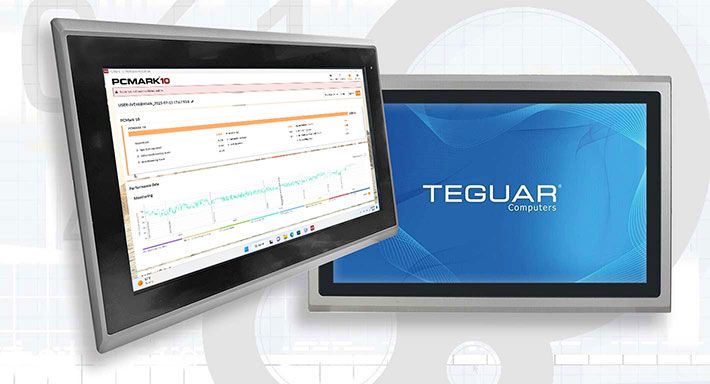
Why use the same design for two series of full computers as well as a series for industrial monitors? Because the display is the human-machine interface; the location of the actual computer isn't always important. With panel computers, it's often simpler to have the screen and the computer in the same package rather than installing, wiring, and maintaining two separate devices. On the other hand, keeping the PC and the monitor separate allows for hooking the display up to whatever type and class of computer is best suited for the job.
There really is a need for both, and so Teguar offers both types in the same form factor and largely the same selection of different display sizes. And it's also why the company offers the AIO models with integrated computers with two different levels of performance. It all makes sense. Panel displays used in industrial applications must be tough and rugged — be they used as all-in-one PCs or just as monitors — something which consumer monitors, or any consumer technology displays, definitely are not. And not all panel mount computers need the same level of performance.
Teguar's TP-5645 Series of industrial panel-mount PCs: concept and models
Industrial panel-mount computers are different from most stand-alone systems. They are built from the ground up to withstand the perils of industrial environments. And since panel-mounts are stationary devices that won't be moved around, weight is much less of an issue than it is for mobile computers. As a result, while there is a substantial difference between a rugged and a non-rugged laptop or tablet, the difference between a run-of-the-mill office monitor and an industrial monitor is far greater. Industrial panel-mounts like the TP-5645 models are truly built like tanks. Here are the primary features of the line:
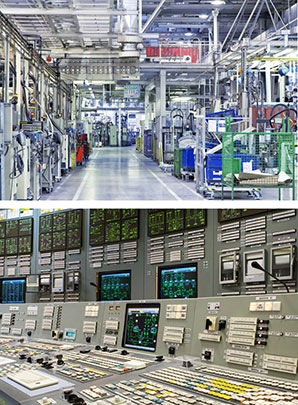
- All use rugged, heavy-duty die-cast aluminum enclosures that are nearly indestructible.
- They come with displays as small as 12-inches diagonal and as large as 22-inches diagonal.
- All have an IP66-protected flat front panel that are fully protected from dust and can handle strong jets of water.
- All models are available with resistive or optional projected capacitive touch screens.
- All have a wide 9~36 Volt DC power input range.
- Most models offer optional high-bright sunlight-readable 1000 Nits LCDs.
- All come standard with the same Intel Core i3-8145UE processor, with an even more powerful Core i5-8365UE CPU as an option.
- All have the same basic complement of interface ports, but also offer customizable inputs and outputs.
- All offer long-term availability and support. The TP-5645 line, for example, will be around until at least 2030.
- Display resolutions and pixel density vary between models, and different luminance options are available for all models.
At this point you may wonder why, given the rapid advance in computer technology — processors, memory, storage, interfaces, expansion, etc., — it even makes sense to integrate everything into one package. In response, Teguar points out that industrial PCs have far more predictable functional and performance requirements than consumer and enterprise PCs.
For that reason, reliability, longevity, minimal maintenance and extended lifecycles matter. The emphasis is on systems that get the job done without breaking down even if they are exposed to potential abuse (environment, vandalism, etc.). Selecting reliable panel-mount PCs is less costly and disruptive than having separate monitors and system units. Finally, having everything in one box with the same processor, same ports, and same system formware allows for easier running and maintenance.
The table below shows Teguar's entire range of TP-5645 Series of industrial panel-mount PCs:
|
Teguar TP-5645 Series Industrial Panel Mount PC lineup
|
|
Company
|
Teguar
|
Teguar
|
Teguar
|
Teguar
|
Teguar
|
Teguar
|
Teguar
|
|
Model
|
TP-5645-12
|
TP-5645-15
|
TP-5645-16
|
TP-5645-17
|
TP-5645-18
|
TP-5645-19
|
TP-5645-22
|
|
CPU
|
Core i3-8145UE
|
Core i3-8145UE
|
Core i3-8145UE
|
Core i3-8145UE
|
Core i3-8145UE
|
Core i3-8145UE
|
Core i3-8145UE
|
|
opt. CPU
|
Core i5-8365UE
|
Core i5-8365UE
|
Core i5-8365UE
|
Core i5-8365UE
|
Core i5-8365UE
|
Core i5-8365UE
|
Core i5-8365UE
|
|
RAM
|
4-32GB DDR4
|
4-32GB DDR4
|
4-32GB DDR4
|
4-32GB DDR4
|
4-32GB DDR4
|
4-32GB DDR4
|
4-32GB DDR4
|
|
Storage
|
128GB-1TB M.2
|
128GB-1TB M.2
|
128GB-1TB M.2
|
128GB-1TB M.2
|
128GB-1TB M.2
|
128GB-1TB M.2
|
128GB-1TB M.2
|
|
Expansion
|
1 x Mini-PCIe
|
1 x Mini-PCIe
|
1 x Mini-PCIe
|
1 x Mini-PCIe
|
1 x Mini-PCIe
|
1 x Mini-PCIe
|
1 x Mini-PCIe
|
|
Cards
|
1 x Nano SIM
|
1 x Nano SIM
|
NA
|
NA
|
NA
|
NA
|
NA
|
|
Actual size
|
12.1-inch
|
15.0-inch
|
15.6-inch
|
17.0-inch
|
18.5-inch
|
19.0-inch
|
21.5-inch
|
|
Resolution
|
1024x768
|
1024x768
|
1920x1080
|
1280x1024
|
1920x1080
|
1280x1024
|
1920x1080
|
|
Opt. res.
|
NA
|
NA
|
NA
|
NA
|
NA
|
NA
|
NA
|
|
PPI
|
106
|
85
|
141
|
96
|
119
|
86
|
102
|
|
Aspect ratio
|
4:3
|
4:3
|
16:9
|
5:4
|
16:9
|
5:4
|
16:9
|
|
Luminance
|
500/1000
|
300/1000
|
450/1000
|
350/NA
|
300/1000
|
350/NA
|
250/1000
|
|
Resistive
|
Available
|
Available
|
Available
|
Available
|
Available
|
Available
|
Available
|
|
P-Cap
|
Available
|
Available
|
Available
|
Available
|
Available
|
Available
|
Available
|
|
Power
|
DC 9~36
|
DC 9~36
|
DC 9~36
|
DC 9~36
|
DC 9~36
|
DC 9~36
|
DC 9~36
|
|
Battery
|
opt. 20 min
|
opt. 20 min
|
opt. 20 min
|
opt. 20 min
|
opt. 20 min
|
opt. 20 min
|
opt. 20 min
|
|
Weight (lb)
|
6.0
|
9.5
|
9.5
|
13.9
|
14.8
|
15.9
|
16.5
|
|
Size (mm)
|
319x245x52
|
410x310x67
|
412x278x59
|
439x348x65
|
500x315x65
|
468x380x65
|
557x362x65
|
|
VGA
|
no
|
no
|
no
|
no
|
no
|
no
|
no
|
|
DVI-D
|
no
|
no
|
no
|
no
|
no
|
no
|
no
|
|
HDMI
|
no
|
no
|
no
|
no
|
no
|
no
|
no
|
|
DP
|
yes
|
yes
|
yes
|
yes
|
yes
|
yes
|
yes
|
|
USB 2.0
|
no
|
no
|
no
|
no
|
no
|
no
|
no
|
|
USB 3.1
|
4 Type A
|
4 Type A
|
4 Type A
|
4 Type A
|
4 Type A
|
4 Type A
|
4 Type A
|
|
USB Type-C
|
no
|
no
|
no
|
no
|
no
|
no
|
no
|
|
RS232
|
1 x COM
|
1 x COM
|
1 x COM
|
1 x COM
|
1 x COM
|
1 x COM
|
1 x COM
|
|
RJ45
|
2 x RJ45
|
2 x RJ45
|
2 x RJ45
|
2 x RJ45
|
2 x RJ45
|
2 x RJ45
|
2 x RJ45
|
|
IP
|
IP66 front
|
IP66 front
|
IP66 front
|
IP66 front
|
IP66 front
|
IP66 front
|
IP66 front
|
|
VESA
|
100
|
100
|
100
|
100
|
100
|
100
|
100
|
The table highlights the similarity and cohesiveness between the ten models of the TP-5645 industrial panel-mount series listed as of July 2023. They all share the same basic design, but vary in display size from 12 inches diagonal all the way to 21.5 inches diagonal.
Note the variety in display aspect ratios between the various models, ranging from a squarish 15:12 in the 17-inch and 19-inch models to the wide-format 16:9 in the 16-inch version we tested as well as the 18-inch and the 22-inch models. The 12-inch, and 15-inch designs have displays with the older 4:3 aspect ratio. Each aspect ratio has its uses, software coded for it, or applications that work best with it.
As is to be expected from the large range of screen sizes, display resolution varies — from 1024 x 768 pixel in the two smallest units, up to 1920 x 1080 pixel in two of the largest. Pixel density varies widely also, from 141 ppi (pixels per inch) on the 16-inch monitor, down to just 85 ppi in the 15-inch version. Note that pixel density is not an absolute measure where higher density is always better. Pixel density must be matched to display size and application. There are smartphones with insanely high pixel densities in the 850ppi range, but an "ultra-high definition" 70-inch 4k TV only has 63 pixels per inch. It all depends on the application and the viewing distance.
 Note that the 4:3 aspect ratio/1024 x 768 pixel format has long been a standard for many industry-specific software applications and solutions, whereas 16:9/1920 x 1080 pixel is generally favored for multi-media and video applications.
Note that the 4:3 aspect ratio/1024 x 768 pixel format has long been a standard for many industry-specific software applications and solutions, whereas 16:9/1920 x 1080 pixel is generally favored for multi-media and video applications.
Another difference between the displays is their default luminance (screen brightness), which ranges from 250 (22 inch) to 500 (12 inch) nits in this lineup. All but the 17-inch and 19-inch versions, however, are also available with a super-bright 1,000 nits option for outdoor applications.
On the computer side of things, the differences are minimal. All units come standard with the same Intel Core i3-8145UE processor, a dual-core/quad-thread design that's part of Intel's "Whiskey Lake" series. The chip is based on one of Intel's high-performance Core architectures that's much more complex and costly than Intel's low end "Atom" processor lines. Optionally available for all models in the line is the Intel Core i5-8365UE, a fairly significant step up in performance. Both processors carry Intel's "embedded" designation, which generally means the chip will remain available for an extended period of time.
All systems can be equipped with as little as 4GB (we recommend at least 8GB) and as much as 32GB of RAM. Mass storage is from 128GB to as much as 1TB of SATA/600 solid state using the M.2 slot interface. All have a Mini-PCIe slot that can be used for add-on functionality such as Wifi/Bluetooth, mobile broadband or other. Some have a Nano SIM card slot. As far as operating systems, that can be Windows 10 IoT, Windows 11, or Linux.
One difference between the PC and the monitor versions is that the latter have an OSD (On Screen Display) membrane control panel that allows access to the usual variety of display settings, and the former doesn't.
Now let's take a closer look at the TP-5645-16 sample unit Teguar sent RuggedPCReview.com for evaluation and testing.
Teguar TP-5645-16 industrial panel-mount PC
In terms of display size, the TP-5645-16 sits closer to the top than the bottom of Teguar's TP-5645 industrial Panel PC series. Its display measures 15.6 inches diagonally in the wide-format 16:9 aspect ratio, just like the majority of computer displays these days. This being an industrial-grade panel computer, the TP-5645-16 weighs almost ten pounds — an exceedingly solid piece of equipment. There isn't any lightweight plastic here.
The first impression one gets of the Teguar TP-5645-16 is how substantial and incredibly solid it feels. The panel looks like it's milled out of a solid block of steel. That would neither be necessary nor feasible, but this Teguar computer (and in fact the entire line) is the next best thing: die-cast aluminum front and back. Even with high-powered Intel Core processors, there is no need for a fan here; the mass of all that aluminum is plenty enough to act as a heat sink and heat spreader, keeping everything nice and cool.
The front bezel is a solid, cast piece of aluminum with the screen flush-mounted and with a generous margin around the actual LCD, as it should be for a touch-operated device. The aluminum bezel around the touch screen also serves as a buffer to protect the touch screen from impacts from the side.
Below is what the Teguar TP-5645-16 looks like from the front and all four sides.
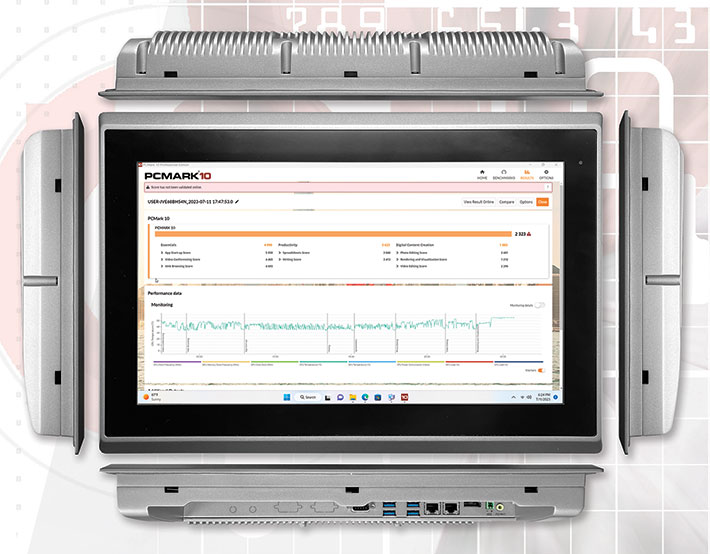
Finning on the backside of the TP-5645-16 adds additional heat-dissipating surface to the panel. That seems hardly necessary given the massive metal housing, but it makes for a nice high-tech look and renders the panel just that much more immune to overheating with its powerful processor.
 To the right you can see what the TP-5645-16 looks like from the rear. On the left is the green power terminal block. Our machine came with an external power brick, but the monitor can handle a wide 9~36 range of DC input voltages.
To the right you can see what the TP-5645-16 looks like from the rear. On the left is the green power terminal block. Our machine came with an external power brick, but the monitor can handle a wide 9~36 range of DC input voltages.
For wall, desk stand, or other articulating arm mounting, there's the standard 100 x 100 mm VESA screw hole pattern. Sitting inside the pattern is an access door that covers the panel's data storage bay. While that same compartment contained a quick-remove metal caddy that held a single 2-1/2-inch SATA solid state disk in our TP-3445 unit, in the TP-5645 there's a tiny 128GB Transcend TS128GMTS552T M.2 2242 SATA III solid state disk module.
Note the absence of speaker grilles or cutouts. That's because these industrial monitors are not meant for movie or YouTube viewing. If there is a need for sound, all ten models in the TP-5645 industrial panel-mount PC series do have a speaker/audio port, and the spec sheets of some models list optional speakers.
Below is a look at the TP-5645-16 panel's input/output area, which is, apart from size-related positioning and configuration, functionally identical in all ten models. The emphasis here is on covering the basics. All ten models have a couple of RJ45 LAN ports, four USB 3.1 Type-A ports, a COM port, a DisplayPort connector for external video, and audio-out. Beyond that, customers can specify additional IO. Options include additional COM ports or GPIO, and a Mini-PCIe slot for unique IO needs.

Note that all of these Teguar industrial panel-mount PCs are listed as having their front panel IP66 protected. IP66 means totally dust-proof, and also able to withstand a strong jet of water. Why only the front panel? Because most such monitors will be panel-mounted in one way or another. It would make no sense to also seal the backside of the device that's inside a panel.
Opening up one of these Teguar industrial monitors should rarely become necessary. There are no rotating hard disks or fans or much of anything else that could break or need upgrading. We, of course, took it apart anyway (the implementation and quality of what's inside matters as much as what's outside. It's easy. Undo ten Philips screws and the big die-cast aluminum back comes off. Careful, though: there are several wires between the two parts.
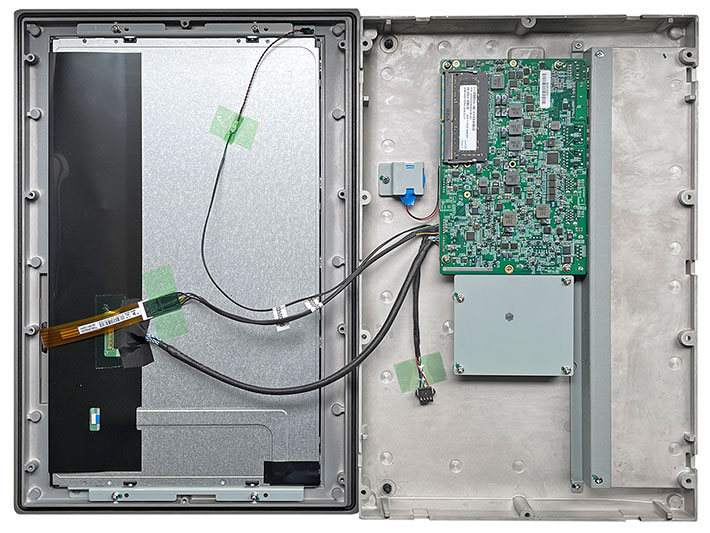
Above you can see what it looks like inside. Our 16-inch review unit had plenty of extra room for options such as an uninterrupted power supply that provides up to 20 minutes of operation in the event of a power loss. So if there is an unexpected power outage, users have time to complete work, save all data and then gracefully shut down the computer. On the roughly 4-1/2 x 6-1/2 inch motherboard you can also see the single SODIMM RAM slot.
Intel "Whiskey Lake" processor
The major difference between the Teguar TP-3445 and TP-5645 Series is in the processor and ancillary electronics. The Intel Core i3-8145UE chip that comes standard with all TP-5645 models is a significant step above the Pentium N4200 found in all TP-3445 models.
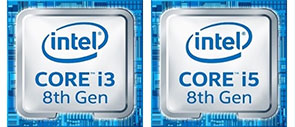 While Intel, initially just another processor manufacturer among many, was amazingly successful with its "Intel Inside" sticker on virtually every PC, the fact is that the type and kind of Intel chip inside is key to meeting customer expectations.
While Intel, initially just another processor manufacturer among many, was amazingly successful with its "Intel Inside" sticker on virtually every PC, the fact is that the type and kind of Intel chip inside is key to meeting customer expectations.
As is, the Teguar TP-5645 Series benefits from the availability of two Intel 8th generation "Whiskey Lake" Core processors. What's the meaning and relevance of the term "Whiskey Lake"? Nothing really, it's just a code name. Those following the bewildering variety of Intel chips and chip generations might now say, "Isn't Intel's 8th generation code-named Coffee Lake"? The answer is, "it depends." The 8th generation started as "Coffee Lake" with 14nm process technology, but then Intel also added 10nm "Cannon Lake" chips to the 8th generation, and just for good measure, then also threw in even more optimized mobile 14nm "Whiskey Lake" chips (and when the 9th generation appeared, Intel called those "Coffee Lake Refresh." Go figure.) The tablet to the right shows what customers can choose from:
The table below shows the two processors available for the Teguar TP-5645, with their major specs (see the full table here):
|
|
CPU Options
|
Intel
|
Intel
|
|
|
Intel
|
Core i3-8145UE
|
Core i5-8365UE
|
|
|
Codename
|
Whiskey Lake
|
Whiskey Lake
|
|
|
Cores/Threads
|
2/4
|
4/8
|
|
|
Lithography
|
14mn
|
14mn
|
|
|
Base Clock Speed
|
2.20 GHz
|
1.60 GHz
|
|
|
Turbo Speed
|
3.90 GHz
|
4.10 GHz
|
|
|
Thermal Design Power (TDP)
|
15 watts
|
15 watts
|
|
|
Smart Cache
|
4MB
|
6MB
|
|
|
Integrated graphics
|
Intel UHD Graphics 620
|
Intel UHD Graphics 620
|
|
|
Graphics base speed
|
300 MHz
|
300 MHz
|
|
|
Graphics max speed
|
1.00 GHz
|
1.05 GHz
|
|
|
Intel vPro
|
No
|
Yes
|
|
|
Intel Trusted Execution
|
No
|
Yes
|
|
|
CPU relative cost
|
1.00
|
1.06
|
The default processor is the Core i3-8145UE. The "U" stands for ultra-low voltage and the "E" stands for embedded, which in this context means Intel will make the chip available for an extended period of time. The big difference between the two processors is that that the i3-8145UE is a dual-core design whereas the optional i5-8365UE is a quad-core design.
Just having two cores instead of four isn't necessarily bad. The base clock speed of the i3-8145UE is actually higher than that of the i5-8365UE; Intel probably did that to keep power consumption of the quad-core chip down (all the ultra-low voltage chips are primarily targeted at mobile devices such as tablets and laptops). As a result, the i3-8145U will probably handle light loads and routine jobs just as well as the higher-end i5 option.
That said, the Core i5-8365UE has four cores and eight threads and it has more Smart Cache (6mb instead of 4mb). In retrospect, Intel's 8th gen became a milestone generation or mobile systems -- it was the first that brought much appreciated quad-core designs to the ultra-low voltage mobile space.
To provide an idea of the relative performance of the TP-5645-16, we tested, we used our standard benchmark suites, Passmark Software's Performance Test 6.1 and 9.0, CrystalMark, PC Mark 10, 3D Mark and GeekBench. For comparison we added the results of the except for the processor almost identical Teguar TP-3445-16 All-in-One, and the newer Elkhart Lake powered Teguar TP-4840-22 and the Intel "Tiger Lake" 11th gen powered TP-5940-18 industrial All-in-Ones that we recently reviewed. Here are the results:
|
Teguar TP-5645-16 performance in comparison
|
|
PERFORMANCE COMPARISON
|
Teguar
|
Teguar
|
Teguar
|
Teguar
|
|
Model
|
TP-5645-16
|
TP-3445-16
|
TP-5940-18
|
TP-4840-22
|
|
|

|

|

|

|
|
Model
|
Panel Mount PC
|
Panel Mount PC
|
All-in-One
|
All-in-One
|
|
Year tested
|
2023
|
2021
|
2023
|
2023
|
|
Processor Type: Intel
|
Core
|
Pentium
|
Core
|
Celeron
|
|
Processor Model
|
i3-8145UE
|
N4200
|
i5-1145G7
|
J6412
|
|
Processor Code
|
Whiskey Lake
|
Apollo Lake
|
Tiger Lake
|
Elkhart Lake
|
|
CPU Speed
|
2.20GHz
|
1.10GHz
|
2.60GHz
|
2.00GHz
|
|
Turbo Speed
|
3.90GHz
|
2.50GHz
|
4.10GHz
|
2.60GHz
|
|
Thermal Design Power (TDP)
|
15 watts
|
6 watts
|
12/28 watts
|
10 watts
|
|
Overall PassMark 6.1
|
1,558.2
|
1,336.9
|
6,157.9
|
3,087.4
|
|
Overall PassMark 9.0
|
1,975.1
|
1,339.2
|
4,233.6
|
1,868.5
|
|
Overall CrystalMark
|
159,839
|
154,432
|
444,711
|
220,079
|
|
Overall PC Mark 10
|
2,323.0
|
1,697.0
|
4,452.0
|
2,192.0
|
|
GeekBench 5 Single Core
|
583
|
323
|
1,250
|
590
|
|
GeekBench 5 Multi Core
|
1,269
|
609
|
3,433
|
1,819
|
|
GeekBench 5 Open CL
|
4,398
|
720
|
8,764
|
2,229
|
The results of the benchmark tests allow some definite conclusions, and they are also much in line with what we've learned from benchmarking many hundreds of rugged mobile, industrial IPCs, and panel computers.
First, in terms of performance, Intel Core processor-based systems virtually always beat systems based on Intel's Atom architectures. So anyone who needs a high-performance panel mount will most likely pick Teguar's Intel Core-based TP-5645 line over the otherwise pretty much identical but Intel Atom-based TP-3445 line. That said, the speed difference between the TP-5645-16 and the TP-3445-16 wasn't as much as we had expected. So if performance matters most, we'd go with the optional quad-core i5-8365UE chip.
Second, chip generations matter. For example, the (newer) Atom architecture-based TP-4840-22 is at least a match for the (older) Core architecture-based TP-5645-16 in performance, so a newer Atom-based chip can approach, match or even beat an older Core-based chip.
Finally, note the huge generational progress even within processor types! The newer "Elkhart Lake" Atom-based Celeron J6412 blows away the older "Apollo Lake" Atom-based Pentium by a good margin. Likewise, the 11th gen "Tiger Lake" Core-based i5-1145G7 performs at a much higher level than the 8th gen "Whiskey Lake" Core-based i3-8145UE.
Processor performance isn't everything. But not enough performance for a task or application can become a big frustration. So do make sure you match systems and processor performance to the tasks at hand, and also keep in mind that overall system performance doesn't only depend on the processor; having enough RAM is also important (especially with Core processer-based systems!), and the type of mass storage, too, can have a major impact of overall systems performance.
LCD luminance
Since industrial panels may be used indoors as well as outdoors, it makes sense to offers two brightness options. For indoors, 250 to 450 is plenty bright enough (a good laptop is around 250 nits, a modern tablet in the 400-550 nits range), but for use in direct sunlight it may not be enough. It wouldn't make sense to put a high-bright screen into a panel when the brightness isn't needed. As a result, Teguar offers most of their industrial panel PCs with a high-bright 1000 nits option.
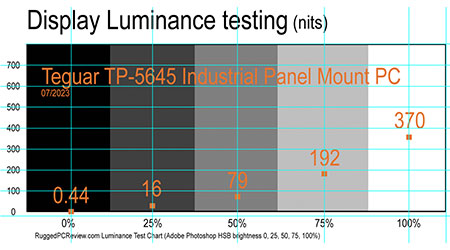 How does one measure the brightness of a computer screen? That's where luminance, the intensity of light emitted, comes in. Luminance is measured in candela per square meter, where candela refers to luminous intensity, the power emitted by a light source.
How does one measure the brightness of a computer screen? That's where luminance, the intensity of light emitted, comes in. Luminance is measured in candela per square meter, where candela refers to luminous intensity, the power emitted by a light source.
Since "candela per square meter" is a bit cumbersome, the industry uses "nits" which really is just short for "units".
We measured screen luminance of the TP-5645-16 at five different levels of HSB brightness (see table to the right) and found a maximum luminance of 370 nits.
Given that the product specs say 450 nits, why did we find just 370? That's because our sample unit came with a resistive touch screen. Resistive touch screen technology offers between 75 and 85% light transmission, which explains the 370 nits — about 82% of the the 450 the LCD backlight itself generates. That is still plenty bright, brighter than many premium consumer tablets.
Since our sample came with resistive touch, we couldn't measure luminance of the capacitive touch option that Teguar offers. It could be in the 90-98% range, so keep that in mind if maximum brightness matters.
Teguar TP-5645 Series — Summary
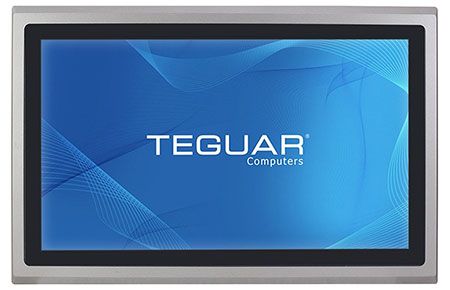 With their TP-5645 Series, Teguar offers a versatile lineup of heavy-duty industrial-grade panel-mount PCs that can easily be installed into control cabinets, onto VESA-standard arms or in numerous other ways. Based on "Whiskey Lake" Intel 8th generation Core processors, all TP-5645 models provide considerable computing performance for advanced applications.
With their TP-5645 Series, Teguar offers a versatile lineup of heavy-duty industrial-grade panel-mount PCs that can easily be installed into control cabinets, onto VESA-standard arms or in numerous other ways. Based on "Whiskey Lake" Intel 8th generation Core processors, all TP-5645 models provide considerable computing performance for advanced applications.
Available in screen sizes from 12 to 21.5 inches, these touchscreen computers can serve as the graphical user interface for machine operation, data viewing, self service activities, or interaction with ERP software.
Employing die-cast aluminum and steel construction, Teguar's TP-5645 industrial panel-mount PCs feel rock-solid and they are meticulously made. Depending on the application, customers can specify resistive or capacitive touch. Likewise, the series is easily customized with all sorts of additional I/O.
Fanless design means completely silent operation, no potentially disturbing airflows, and no mechanical fan that may fail.
Teguar offers all TP-5645 models with optional high-bright (1,000 nits) display versions for daylight readable deployments.
After examining, using, and taking apart a sample of the Intel Core processor-based Teguar TP-5645 line of industrial panel-mount PCs, as well as studying the specs and features of all models of the series, we came away impressed with their design, solid build, performance, functionality, and overall quality. —
Conrad H. Blickenstorfer, July 2023
 Teguar — 1-800-870-7715
Teguar — 1-800-870-7715
www.teguar.com






